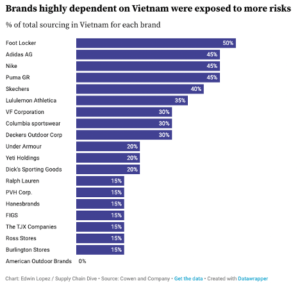Supply Chain Disruptions Create New ReCommerce Opportunities
Keep Up with Increased Consumer Demand Amid Supply Chain DisruptionsThe COVID-19 outbreak, and subsequent quarantine, have created new challenges throughout the supply chain that are opening retailer’s eyes to new possibilities in the recommerce market. Even before the shutdowns, retailers were starting to embrace the concept of renewing and reselling used goods. With demand only increasing, manufacturers are struggling to keep up with consumer demand due to the supply chain issues that are plaguing the global economy. This combination of increasing demand and dwindling supply has fostered a new vigor for a recommerce solution to keep revenues healthy.
Despite Changes, Consumer Demand is at an All-Time High
Starting in March of 2020, consumers were forced to dramatically change their spending habits. People went from spending money at restaurants and bars to spending money on groceries. Money that was spent on gym memberships was soon being spent on home gym equipment. Consumers had to completely change how they spent their money as lockdowns and shutdowns kept people indoors for extended periods of time.
Despite all of these changes, consumer demand continues to grow. According to McKinsey & Company, a US-based consultancy firm, “High levels of optimism and spend through July and August, even as the Delta variant spread in the US, have been driven by higher-income and younger consumers (optimism at 57 percent and 59 percent; spending growth of 11 percent and 15 percent year over year relative to pre-COVID-19 respectively).” This growth in spending is being seen almost exclusively in online shopping as consumers move away from traditional brick-and-mortar shopping. According to Numerator Insights data, “roughly 87% of shoppers placed online orders for delivery between March 2020 and December 2020, and 51% placed online orders for in-store or curbside pickup. These services attracted the most first-time shoppers in the spring, but have continued to attract first-time and first-time-recently shoppers throughout the pandemic.”
Because of these increases in demand, and changes in shopping behavior, retailers and manufactures are faced with a new problem: supply chain shortages. Global shutdowns and lockdowns have placed huge bottlenecks in the supply/demand cycle, creating supply chain issues that will persist for years.
The Supply Chain Continues to Present Challenges
Manufacturers struggled to keep up with these changes amid their own shutdowns and shortages. The global economy was subject to massive shortfalls beginning in the second half of 2020 that are still being felt today. The technology sector felt the largest impact across retail goods as the countries that supply the largest share of the world’s electronic components shut down. Now, with the delta variant of the Coronavirus creating new quarantines, relief of these shortages gets pushed further back.
One of the largest impacts on the global supply chain continues to be renewed shutdowns and quarantine measures in Vietnam. Vietnam is a major production hub for consumer goods and components throughout the world ranging from clothing and shoes to electronic components. Computers that are manufactured in China and Korea depend on components that are made and assembled in Vietnam. Even if factories in other countries are running at full speed, they don’t have the parts that they need.
To complicate matters further, COVID-19 lockdowns have severely impacted Vietnam’s ability to ship good out. Massive labor shortages have left Vietnam’s ports congested and at a virtual stand-still. “Unlike the other ports in US and some ports in China, the Vietnam dwell times and congestion were mainly related to COVID-19 lock downs,” said Josh Brazil, vice president of supply chain insights at project44. According to Brazil, the workforce available at Vietnam ports dropped “by about 50%.”
Major manufacturers across the globe face huge impacts from the COVID-19 quarantines and lockdowns in Vietnam. The following graph shows just how high the risks for losses are for some of the largest companies that rely on Vietnam and I’s ports for production:
With consumer demand not slowing down, even in light of wide-spread supply chain issues, how can retailers and manufacturers reduce their risks for loss and keep revenues healthy?
ReCommerce: An Expanded Approach to New Challenges
Retailers have seen the growth of recommerce programs steadily increase over the last 5-6 years. Market studies continue to show that consumers are not shy about buying used goods online, in fact, According to Forbes, “The research firm Cowen showed recommerce (including resale, rental and subscription models) would account for 14% of the apparel, footwear and accessories market by 2024, up from about 7% in 2020. Resale platform ThredUp suggests that apparel resale alone will be a $64 billion market by 2024.”
Given the combination of consumer purchasing trends coupled with supply chain shortages, it’s a safe bet that recommerce markets are only going continue to grow – if anything, they are going to grow faster. The time for retailers and manufacturers to take control of their own recommerce future is now.
Move Forward with Purpose
Just because the timing for the recommerce market is prime right now doesn’t mean that the conditions will make it easy. The same supply chain issues that are plaguing the new merchandise market are going to vex the resale market. Logistical issues will make getting the used goods from consumers difficult. Labor shortages will make refurbishing goods a challenge. The road to a successful recommerce program is a difficult one in 2021.
These issues all point to why you should work with a recommerce expert like 1GNITE. We know the markets, we understand the challenges, and we create innovative and effective solutions to make sure that your revenue streams continue to flow in the right direction. We have worked with major retailers across the country to design and implement take-back and re-sale programs that are enough of a closed-loop to prevent impacts from supply chain issues and labor shortages.
Contact us today and let us see how we can help your business navigate the stormy waters of the post-covid recommerce market to take full advantage of the current consumer trends. Our experts are ready to work with your team and create a lasting, sustainable solution.
-
Circular Economy Definition: Everything You Need to Know
-
Top 5 Benefits Of The Circular Economy
-
The 4 Most Important Circularity Metrics to Measure Your Success in 2022
-
Circular Economy: 6 Fastest Ways To Become Circular
-
How Sustainability is the Key to Solving Supply Chain Issues
-
5 Benefits of an Internal Marketplace You Must Know










